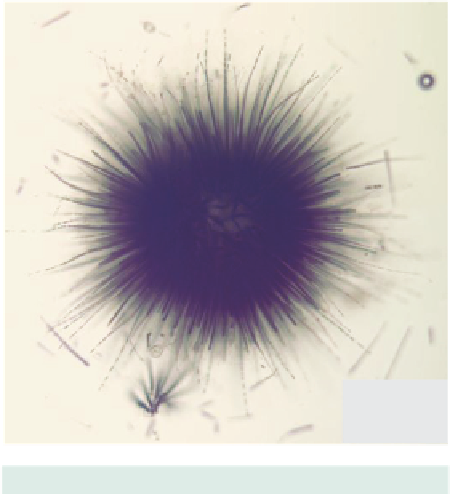Environmental Engineering Reference
In-Depth Information
soil, stones and rocks. Occurs in waters,
muds or moist soils that are unpolluted or
only slightly eutrophic - often forming dark
green patches. Cells 3.5-6 μm in diameter,
4-13 μm long. Cyanophyta. Plate VII.
(b) Heterocysts not terminal but intercalary
.....................................
51
51
(50) (a) Each end of the trichome tapers slightly
(occasionally slightly curved) and is some-
what elongated. Gonidia, when present, soli-
tary.....................
Aphanizomenon
Trichomes of
Aphanizomenon
may be
grouped together like sheaths of wheat to
form 'rafts' visible to the naked eye (
A.
flos-aquae)
) or be solitary (
A. gracile
,
A.
issatschenkoi
and
A. aphanizomenoides
).
The trichomes are relatively short, showing
a slight taper at each end, with no sheath.
Cells are rectangular, 5-6 μm diameter and
8-12 μm long, with slight constrictions at
the cross walls. Heterocysts are cylindrical
(7 μm diameter, 12-29 μm long) and located
in the mid-region of the trichome. Goni-
dia (about 8 μm diameter, 60-70 μm long)
are also cylindrical and in the mid-region
but not adjacent to the heterocysts. Com-
mon in the plankton especially in nutrient-
rich lakes where it can form dense blooms.
Aphanizomenon
is one of the genera of
blue-green algae that has been reported to
produce toxins in water. Four such toxins
have been associated with this genus - sax-
itoxin, cylindrospermopsin, anatoxin-a and
lypopolysaccharides. (Chorus & Bartrum,
1999). Cyanophyta. Plate VII. Fig. 4.23.
200 μm
Figure 4.22
Gloeotrichia.
Single colony showing
radiating filaments. Fixed, iodine stained.
Rivularia
colonies are sub-spherical to glob-
ular and contain numerous filaments that are
attached to a substratum. The colony con-
sists of tapering filaments each of which has
a basal heterocyst. The tapering trichome
often ends in a long hair. False branching,
although uncommon, may occur. The tri-
chomes are often radially arranged in firm
mucilage. Hormogonia may be produced at
the end of the trichome. Most frequently
found in hard waters, possibly where there
are periods of higher phosphorus concentra-
tions, and colonies may exhibit some calcifi-
cation. Cyanophyta. Plate VII.
50
(47) (a) Heterocysts terminal, gonidia ellip-
soidal to ovate adjoining the heterocyst
.......................
Cylindrospermum
(b) End cells of trichome not narrower than
the rest so trichome does not taper . .....
52
Cylindrospermum
is characterised by its ter-
minal heterocyst which may be at one or
both ends of a trichome. A large akinete
may be present, often next to the hetero-
cyst. The trichomes are usually loosely tan-
gled in soft mucilage and grow on damp
52
(51) (a) Trichomes solitary or in a tangled, some-
timescoiled,mass.............
Anabaena
There are many species of
Anabaena.
The
trichomes are fairly easy to recognise and

Search WWH ::

Custom Search